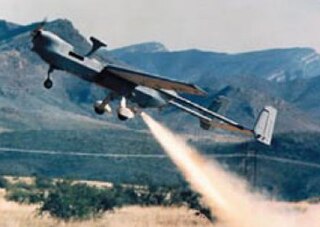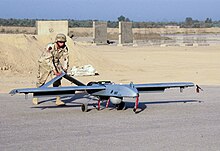
The AAI RQ-2 Pioneer is an unmanned aerial vehicle (UAV) that had been used by the United States Navy, Marine Corps, and Army, and deployed at sea and on land from 1986 until 2007. Initially tested aboard USS Iowa, the RQ-2 Pioneer was placed aboard Iowa-class battleships to provide gunnery spotting, its mission evolving into reconnaissance and surveillance, primarily for amphibious forces.

The IAI RQ-5 Hunter unmanned aerial vehicle (UAV) was originally intended to serve as the United States Army's Short Range UAV system for division and corps commanders. It took off and landed on runways. It used a gimbaled EO/IR sensor to relay its video in real time via a second airborne Hunter over a C-band line-of-sight data link. The RQ-5 is based on the Hunter UAV that was developed by Israel Aerospace Industries.

The AAI RQ-7 Shadow is an American unmanned aerial vehicle (UAV) used by the United States Army, Australian Army, Swedish Army, Turkish Air Force and Italian Army for reconnaissance, surveillance, target acquisition and battle damage assessment. Launched from a trailer-mounted pneumatic catapult, it is recovered with the aid of arresting gear similar to jets on an aircraft carrier. Its gimbal-mounted, digitally stabilized, liquid nitrogen-cooled electro-optical/infrared (EO/IR) camera relays video in real time via a C-band line-of-sight data link to the ground control station (GCS).

The AAI Aerosonde is a small unmanned aerial vehicle (UAV) designed to collect weather data, including temperature, atmospheric pressure, humidity, and wind measurements over oceans and remote areas. The Aerosonde was developed by Insitu, and is now manufactured by Aerosonde Ltd, which is a strategic business of AAI Corporation. The Aerosonde is powered by a modified Enya R120 model aircraft engine, and carries on board a small computer, meteorological instruments, and a GPS receiver for navigation. It is also used by the United States Armed Forces for intelligence, surveillance and reconnaissance (ISR).

AeroVironment, Inc. is an American defense contractor headquartered in Arlington, Virginia, that designs and manufactures unmanned aerial vehicles (UAVs). Paul B. MacCready Jr., a designer of human-powered aircraft, founded the company in 1971. The company is best known for its lightweight human-powered and solar-powered vehicles. The company is the US military's top supplier of small drones —notably the Raven, Switchblade, Wasp and Puma models.

A miniature UAV, small UAV (SUAV), or drone is an unmanned aerial vehicle small enough to be man-portable. Smallest UAVs are called micro air vehicle.

Marine Unmanned Aerial Vehicle Training Squadron 2 (VMUT-2) is an unmanned aerial vehicle training squadron in the United States Marine Corps that is transitioning from operating the RQ-21A Blackjack to the MQ-9A Reaper. The squadron is based at Marine Corps Air Station Cherry Point in Havelock, North Carolina and will serve as the MQ-9A Reaper Fleet Replacement Squadron, training UAS officers and enlisted sensor operators. Historically, VMUT-2 provided aerial surveillance, offensive air support, and electronic warfare for the II Marine Expeditionary Force. VMUT-2 falls under the command of Marine Aircraft Group 14 and the 2nd Marine Aircraft Wing.

Aerosonde Ltd, now part of Textron Systems Unmanned Systems, is an Australian-based developer and manufacturer of unmanned aerial vehicles, including the AAI Corporation Aerosonde series. The company has customers in Australia, Asia and North America who use its vehicles for reconnaissance and meteorological applications.
The 13th Aviation Regiment is a regiment of the United States Army.
The U.S. Department of Defense (DoD) employs Unmanned Aerial Systems (UAS) across all echelons to support tactical, operational, and strategic operations. The types of UAS that are used in these operations are categorized into "Groups" according to their size and capability. Previous to 2010, UAS were categorized into "Tiers" or "Classes" separately by each branch of the military. In order to promote a homogeneous categorization, the "group system" was developed.

Insitu Inc. is an American company that designs, develops and manufactures unmanned aerial systems (UAS). The company is a wholly owned subsidiary of Boeing Defense, Space & Security, and has several offices in the United States, the United Kingdom, and Australia. Its unmanned aerial vehicle (UAV) platforms—ScanEagle, Integrator, Integrator Extended Range (ER), ScanEagle 3 and RQ-21A Blackjack, have logged 1.3 million operational flight hours as of May 2022.

The Carter PAV is a two-bladed, compound autogyro developed by Carter Aviation Technologies to demonstrate slowed rotor technology. The design has an unpowered rotor mounted on top of the fuselage, wings like a conventional fixed-wing aircraft mounted underneath, and a controllable pitch pusher propeller at the rear of the fuselage. Heavy weights are placed in the rotor tips to enhance rotational energy and to reduce flapping.
Carter Aviation Technologies is a privately held aviation research and development company based in Wichita Falls, Texas, United States.

The AeroVironment T-20 unmanned aerial vehicle (UAV) is a medium range, composite aircraft capable of internal and external payloads. Launched from a portable catapult, it can be recovered with a shipboard landing system, or belly land on unimproved surfaces. The T-20 carries a retractable gimbal-mounted, digitally stabilized, electro-optical/infrared (EO/IR) camera that relays video in real time via a C-band LOS data link to the ground control station (GCS). Powered by a 4-stroke, fuel injected gasoline engine, the aircraft burns 2 lb (910 g) of fuel per hour at cruise. AeroVironment, Inc. acquired Arcturus UAV, the original developer of JUMP 20 and T-20 on February 22, 2021.

The Boeing Insitu RQ-21 Blackjack, company name Integrator, is an American unmanned air vehicle designed and built by Boeing Insitu to meet a United States Navy requirement for a small tactical unmanned air system (STUAS). It is a twin-boom, single-engine monoplane, designed as a supplement to the Boeing Scan Eagle. The Integrator weighs 61 kg (134 lb) and uses the same launcher and recovery system as the Scan Eagle.
The Northrop Grumman RQ-180 is an American stealth unmanned aerial vehicle (UAV) surveillance aircraft intended for contested airspace. As of 2019, there had been no images or statements released, but growing evidence points to the existence of the RQ-180 and its use in regular front-line service. The use of the nickname "White Bat" in a 2021 video released by the US Air Force Profession of Arms Center of Excellence (PACE) suggests that the military may be preparing to release information on the RQ-180.
Unmanned aircraft system simulation focuses on training pilots to control an unmanned aircraft or its payload from a control station. Flight simulation involves a device that artificially re-creates aircraft flight and the environment in which it flies for pilot training, design, or other purposes. It includes replicating the equations that govern how aircraft fly, how they react to applications of flight controls, the effects of other aircraft systems, and how the aircraft reacts to external factors such as air density, turbulence, wind shear, cloud, precipitation, etc.

Resolute Eagle is a long-endurance Group 3 unmanned aircraft system (UAS) manufactured and operated by Resolute ISR, Inc. in Howell MI. The Resolute Eagle is a dynamic platform to meet evolving customer requirements. One platform, two configurations. Configuration can be changed in less than 30 minutes. The Standard Fixed Wing configuration launches on a low-pressure Pneumatic launcher and recovers via a Belly-skid landing utilizing a Kevlar skid plate. The Resolute Eagle Hybrid VTOL utilizes two mounted battery-powered booms with four propellers, so it can take off and land like a helicopter—but still, cruise for long distances like a plane. Resolute Eagle utilizes an Applied Navigation Quattro autopilot to transition from Standard Fixed Wing to VTOL configuration.
A weather drone, or weather-sensing uncrewed aerial vehicle (UAV), – is a remotely piloted aircraft weighing less than 25 kg and carrying sensors that collect thermodynamic and kinematic data from the mid and lower atmosphere.















